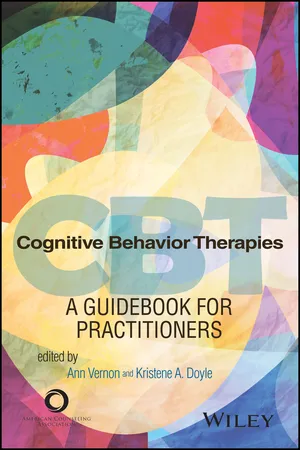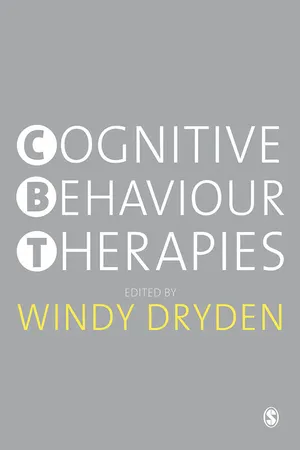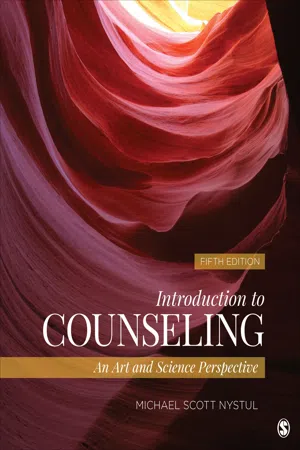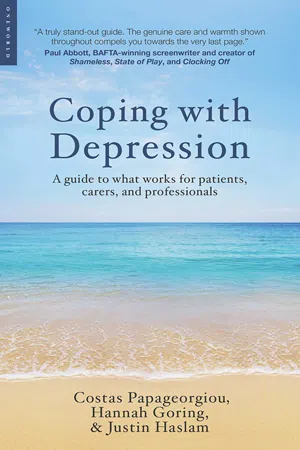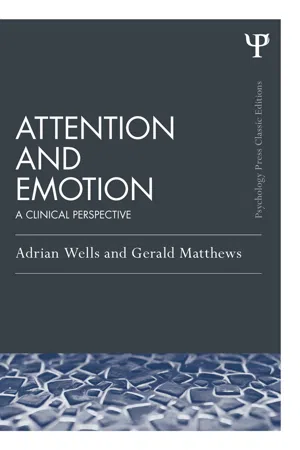Psychology
Aaron Beck
Aaron Beck is a prominent figure in the field of cognitive therapy and is known for developing cognitive therapy, which focuses on identifying and changing negative thought patterns. He is also recognized for his work on depression, where he proposed the cognitive triad theory, suggesting that negative thoughts about the self, the world, and the future contribute to depression.
Written by Perlego with AI-assistance
Related key terms
8 Key excerpts on "Aaron Beck"
- eBook - ePub
Foundations of Counseling and Psychotherapy
Evidence-Based Practices for a Diverse Society
- David Sue, Diane M. Sue(Authors)
- 2012(Publication Date)
- Wiley(Publisher)
Chapter 12
Cognitive-Behavioral Therapy for Depression
The 2006 Lasker Award for Clinical Research was given to Aaron Beck “for the development of cognitive therapy, which has transformed the understanding and treatment of many psychiatric conditions, including depression, suicidal behavior, generalized anxiety, panic attacks, and eating disorders.”The National Academy of Sciences (1997) recognized Aaron Beck, stating “You have almost single-handedly restored the relevance of psychotherapy. Your cognitive therapy is the fastest growing form of psychotherapy and has influenced the treatment of psychiatric disorders throughout the world.”Aaron Beck was named in the American Psychologist (1989) as one of the five most influential psychotherapists of all time. (American Psychologist, 1989)Aaron Beck is a psychiatrist and a Professor Emeritus of Psychiatry at the University of Pennsylvania School of Medicine. He has received numerous awards for his work in cognitive-behavioral therapy. He began his career first as a neurologist and then as a psychoanalyst, conducting research to validate psychodynamic formulations for depression. He was testing the proposition that depression was the result of anger turned inward, manifested in a “need to suffer.” However, his research did not support this hypothesis. He found that depressed individuals sought approval and acceptance from others and avoided behaviors that might lead to rejection. The conflict between the clinical hypothesis derived from psychoanalysis and his research findings forced an “agonizing reappraisal” of Beck’s belief system. This led Beck to search for an explanation regarding the reasons depressed individuals engage in self-criticism and have such a negative outlook on life (Beck et al., 1979). Through his research and clinical work with depressed clients, Beck came to the conclusion that many mental disorders, including depression, were the result of dysfunctional thinking and cognitive structures, which he later called schema - eBook - ePub
Cognitive Behavior Therapies
A Guidebook for Practitioners
- Ann Vernon, Kristene Anne Doyle(Authors)
- 2017(Publication Date)
- American Counseling Association(Publisher)
It is beyond the scope of this chapter to cover all of the developments in CT theory and practice. However, an overview of the theory and practice of this approach, including an emphasis on a variety of CT interventions and specific applications, is presented. Empirical support for this theory is addressed, and you will have an opportunity to learn more about how the theory works by reading the verbatim case transcript illustrating the therapeutic process of CT.Aaron T. Beck: Key Theorist
Aaron T. Beck was born July 18, 1921, in Rhode Island. He attended Brown University as an undergraduate and received his medical degree from Yale in 1946. In 1954 he joined the Department of Psychiatry at the University of Pennsylvania where he is a professor emeritus. Beck is the father of four children. His daughter Judith is also a renowned CT trainer and president of the Beck Institute for Cognitive Behavior Therapy, which her father founded (Aaron T. Beck, n.d.).Beck started developing a cognitive approach to mental disorders in the 1950s while he was working as a psychiatrist and researcher and testing the psychoanalytic theory of depression, namely, that depression is an expression of an unconscious anger toward the self. As the predictions proved to be unsupported, Beck began to have doubts about the scientific status of this theory and instead started to work on the idea that depression might in fact be a form of thought disorder reflecting erroneous patterns of thinking (J. S. Beck, 2011; Padesky, 2004). During the 1960s and 1970s he developed a scale for measuring depressive symptoms, the Beck Depression Inventory (A. T. Beck, Ward, Mendelson, Mock, & Erbaugh, 1961), and published his first books describing the cognitive theory of depression and emotional disorders (A. T. Beck, 1967, 1972, 1976). Also during this period he published the first treatment protocol for depression (A. T. Beck, Rush, Shaw, & Emery, 1979) and conducted the first clinical trial testing the efficacy of his new approach (Rush, Beck, Kovacs, & Hollon, 1977). In fact, this was the first clinical trial comparing in a rigorous scientific manner the efficacy of a psychological intervention with that of medication (Padesky, 2004; Wills, 2009). This was a cornerstone in the evolution of modern psychotherapy and has become a model for the evidence-based approach of psychological interventions. During the same period, Beck also made significant contributions to the scientific study of suicide, introducing the concept of hopelessness and publishing several relevant scales for measuring suicide risk (Padesky, 2004). In the 1980s and 1990s he expanded his research from depression to anxiety disorders, addiction, and even personality disorders. For each of these psychological problems, his approach was to first describe the cognitive model that would explain the symptoms and then develop a treatment and test it in outcome studies (A. T. Beck, Davis, & Freeman, 2004; D. A. Clark & Beck, 2010; Padesky, 2004; Wills, 2009). Toward the second millennium he extended CT theory to the understanding and treatment of schizophrenia (A. T. Beck & Rector, 2000, 2005). - eBook - ePub
- Windy Dryden(Author)
- 2012(Publication Date)
- SAGE Publications Ltd(Publisher)
the cognitive model. He found younger colleagues more receptive and his writings frequently refer to these colleagues as ‘my group’ (Wills, 2009a). The excitement over the efficacy of cognitive therapy became increasingly international. Britain, especially psychologists based in Oxford, responded particularly well to Beck’s work, perhaps because of the pronouncedly pragmatic behavioural tradition in British psychiatry (Rachman, 1997). One can in fact draw a direct line from Beck to the Increasing Access to Psychological Therapy (IAPT) project via David. M. Clark, who did a residency in Philadelphia and played a key role in developing cognitive therapy in Oxford between the 1980s and 2000s. Beck’s publishing record is immense and he is now the second most cited author in the psychotherapy field. Approaching 90 years old, he is still producing many high-quality papers and books. Known as a generous and friendly man, he, unlike Freud, has been willing to let others develop his model. The model has evolved at a continuously rapid rate, so that it is a considerable task to corral its main elements into a single chapter.Table 2.1 Cognitive specificityTheoretical Underpinnings
Major Theoretical Concepts
Discovering negative thoughts amongst his clients initially by chance, Beck went on to test the role that ‘negative automatic thoughts’ (NATs) played in clients’ psychological problems. He found that the effects showed a high degree of cognitive specificity, that is, specific negative cognitions showed a close ‘fit’ with specific negative emotions and behaviours (see Table 2.1 - eBook - ePub
Introduction to Counseling
An Art and Science Perspective
- Michael S. Nystul(Author)
- 2015(Publication Date)
- SAGE Publications, Inc(Publisher)
REBT is an educationally oriented approach that attempts to teach a client how to overcome self-defeating cognitive reactions. One of its strengths is its simplicity. It can be taught to the client in terms as simple as the A-B-C-D-E acronym. In time, clients can learn to use the tools necessary to become their own self-therapists and gain control over their mental health.The major weakness of REBT may be its overemphasis on the role of cognition in the etiology of mental disorders and emotional disturbances. In addition, it may oversimplify what is required to effectively restructure cognition. For many clients, much more may be required than simply changing irrational statements to rational statements. REBT also avoids exploring other factors, such as traumatic early-life experiences, which could represent important treatment considerations.Cognitive Therapy
Background Information
During the mid-1950s, Aaron Beck (b. 1921) developed a cognitively oriented approach to treat mental disorders, rejecting his early training in psychoanalysis. Beck is best known for his work on depression (Beck, 1987, 1991; Beck, Rush, Shaw, & Emery, 1979) and anxiety (Beck & Emery, 1985). His early work on depression resulted in the development of the Beck Depression Inventory, which is widely used as a clinical and research instrument.Theory of Personality
“Cognitive therapy is based on a theory of personality that maintains that people respond to life events through a combination of cognitive, affective, motivational, and behavioral responses (Beck & Weishaar, 2014, p. 231). The theory of personality for cognitive therapy emphasizes the role of cognitive processes on the development of mental disorders such as depression and anxiety. Cognitive therapy contends that the etiology of many mental disorders can be directly traced to cognitive dysfunctions involving misinterpreting environmental cues (e.g., “My friend did not show up, so he must not like me”). - eBook - ePub
Basic Counseling Techniques
A Beginning Therapist's Toolkit
- Wayne Perry(Author)
- 2018(Publication Date)
- TOPLINK PUBLISHING, LLC(Publisher)
We are what we think. All that we are arises with our thoughts. With our thoughts, we make the world. - Bu ddhaMany students turn to cognitive therapy under this mistaken assumption that this style of therapy is easy to use. In reality, when the student turns to cognitive therapy, things quickly get complex. Cognitive therapy is often associated with behavioral therapy (See Chapter 8). While cognitive therapy certainly contains a behavioral emphasis, as it is currently practiced it stems primarily from the work of Aaron Beck and Albert Ellis. Albert Ellis died in July 2007. Aaron Beck was still alive as of the date this is written. Both of these pioneers’ influence is very much alive, so the field of cognitive therapy continues to evolve and gain respect throughout the mental health profession. Other thinkers have moved cognitive therapy into a richly diverse theoretical and therapeutic arena. Purists from the various camps within this large, diverse movement hold to the superiority of their particular variation on the theme.What they all have in common is a belief that cognition is the key to understanding psychological disorders (Alford and Beck, 1997). While the various schools of cognitive therapy may use different terms, they all also agree that humans are meaning-making creatures. Some times the meaning is created deliberately (i.e., consciously), while other times it is created pre-consciously (“automatic thoughts”). Whether consciously or pre-consciously developed, these cognitive meaning structures (“schemas”) give rise to emotions. For example, cognitive therapy would claim that Jim does not feel depressed because his wife left him. Jim feels depressed because of the meaning he assigns to the fact that his wife left him.Cognitive therapists believe that cognitions, that is, the meanings both consciously and pre-consciously associated with events, must change for behavior to change. In turn, behavior must change to reinforce the new and more productive meaning systems the client acquires via therapy (Nichols and Schwartz, 2005). Because of this emphasis on changed behavior as evidence of changed cognition, cognitive therapy has been perhaps one of the best researched styles of therapy. Its emphasis on observable data makes scientific study relatively easy, and thus this style of therapy is among the most well-documented as effective for a variety of psychological problems. As one example, the Beck Institute’s web site states that CBT has been shown to be effective, either singly or as an adjunct to other therapies, in over 1000 outcome studies of a wide variety of mental disorders, including very serious disorders (Beck Institute, 2015). - eBook - ePub
Coping with Depression
A Guide to What Works for Patients, Carers, and Professionals
- Costas Papageorgiou, Hannah Goring, Justin Haslam(Authors)
- 2011(Publication Date)
- Oneworld Publications(Publisher)
According to the cognitive theory of emotional problems, thoughts with particular themes will typically lead to certain emotions. For instance, thoughts in which we judge a situation as threatening or dangerous will usually lead to feelings of fear or anxiety, thoughts in which we appraise a situation as unfair will result in angry feelings, and thoughts about loss or failure will typically lead to feelings of sadness or depression. In any given situation, there are usually many possible interpretations or ways of thinking about it. As well as affecting our emotions, how we interpret or appraise a situation will also have an impact on our subsequent behaviour.Beck’s theory of depression
Perhaps the most widely known cognitive theory of depression was originally developed by Aaron T. Beck in the 1970s.1 , 2This theory links depression to particular thought patterns and to our underlying beliefs, as described below.Negative automatic thoughts
According to Beck’s theory, when people are depressed they tend to have particular types of thoughts, which maintain their depression. These are typically negative thoughts about oneself, about the world in general and about one’s future. For instance, negative thoughts about oneself might include self-critical thoughts such as ‘I’m no good at anything’ or ‘So many bad things have happened to me, it must be my fault.’ Negative thoughts about the world involve interpreting ongoing situations in a negative way. For instance, this might involve interpreting interactions with other people negatively, such as thinking that a friend does not like us or want to spend time with us because they cancelled a meeting at the last minute. Negative thoughts about the future might involve expecting that things will not work out as we had hoped, such as thinking ‘I’ll never get better from this depression’ or ‘I won’t get that job’.Beck noticed that depressed people often have an ongoing stream of negative thoughts with these themes, which he called negative automatic thoughts. These are automatic in that they seem to pop into our minds out of nowhere, rather than being the product of any deliberate reasoning or effortful thinking and, because they are believable, we tend to accept them as true without question. They are often so habitual that we are barely aware of them. They can take the form of words, mental images or pictures, and they can be about the future or about memories of the past. However, they are unhelpful as they make us feel more depressed, which in turn leads to the occurrence of more negative automatic thoughts, forming a vicious circle and downward spiral of depression. The nature of negative automatic thoughts is summarized in box 6.2 - Sonu Shamdasani, Del Loewenthal(Authors)
- 2020(Publication Date)
- Routledge(Publisher)
But neither this manual nor those first-generation manuals which succeeded it were designed for clinical trials. Neither did they describe nor delineate the techniques of a therapy in its entirety. 2 They had a more focal purpose. Our story begins in the next phase, the 1970s, when Aaron Beck repurposed the idea of a manual. Revolutionary virtues attended upon his manual that did not inhere in first-generation ones. Beck’s manual for CTOD Aaron Beck began his career at Penn in the mid-1950s as a psychoanalyst. He specialized in the treatment of depression and conducted psychoanalytic research. As his research progressed, Beck suspected that depression might be a thought disorder – not as severe as schizophrenia but nonetheless evidencing distortions in thought – rather than a mood disorder. Following several professional crises in the early 1960s, he turned his back on organized psychoanalysis. He took a five-year sabbatical (1962–1967) to pursue new ideas about cognitions in depression (Beck, 1967; Rosner, 2012, 2014). He published the two foundational articles on thinking and depression (Beck, 1963, 1964) and his first book (Beck, 1967) during this period of ‘splendid isolation’. This was the period in which cognitive therapy was born. Beck’s frustration with psychoanalysis lay in its culture of dogmatism and loyalty. The professional crises he experienced in the early 1960s were the by-product of a postwar psychoanalytic establishment that held too much power and abused that power with apparent abandon (see Hale, 1995) 3. The analysts in Beck’s orbit who sat in positions of power preached that psychoanalytic theory (especially the unconscious) was inviolable, experimental data were viable only if they supported the theory (and should be thrown out, if not), and skepticism and critique were to be curtailed (with strong-arm tactics, if necessary). Secrecy, not accountability, held sway- eBook - ePub
Attention and Emotion (Classic Edition)
A clinical perspective
- Adrian Wells, Gerald Matthews(Authors)
- 2014(Publication Date)
- Psychology Press(Publisher)
attributions . The mind seems to abhor an informational vacuum, so, if we experience an emotion, we tend to search for an explanation, which may be incorrect. For example, Abramson, Seligman and Teasdale (1978) suggest that depressives are characterised by faulty attributions for negative events, tending to blame themselves rather than other agencies. Typically, the person is aware of the attributional belief, but not the unconscious and possibly automatic information processing which generates it. In practice, we may need quite a complex cognitive model, incorporating a variety of structures and processes (the “architecture” of the model), to provide a satisfactory basis for therapy.Next, we consider Beck’s (1967; 1976; Beck, Rush, Shaw, & Emery, 1979; Beck, Emery, & Greenberg, 1985) theory of emotional disorders, which offers perhaps the most influential and comprehensive account of cognitive processing in emotional disorders. This approach is based on constructs derived from experimental psychology, and is supported by evidence from both clinical observation and rigorous experiment. Our account will illustrate the need for differentiation of cognitive structures and processes, the role of the person’s active construction of a world-view, and the contribution of automatic processes, as just described.Beck’s cognitive theoryBeck’s approach to emotional disorders is essentially a schema theory. It proposes that emotional disorders result from and are maintained by the activation of certain memory structures or schemas. Schemas consist of stored representations of past experience and represent generalisations which guide and organise experience. While individuals possess many different schemas, each one of which represents a different array of stimulus-response configurations, one of the most important schemas involved in psychopathology is the self-schema (e.g. Markus, 1977). This particular schema is used specifically to process information about the self.
Learn about this page
Index pages curate the most relevant extracts from our library of academic textbooks. They’ve been created using an in-house natural language model (NLM), each adding context and meaning to key research topics.

